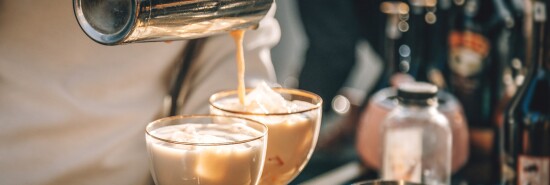
Drink like a droog
Eric Felten
For sheer volume of words produced, it’s hard to beat Ambrose Heath. A newspaper columnist, Heath wrote (and wrote and wrote and wrote and wrote) about comestibles. And in an admirable act of recycling, he turned his many columns into books. He authored Good Food in 1932 and More Good Food in 1933. By the end of 1939, he had cranked out some 20 books more, among them Good Savouries, Good Potato Dishes, Good Soups, Good Sweets, Good Dishes from Tinned Foods, and (the reason I have been reading the groaning shelves born of Heath’s fecund pen) Good Drinks.
I’m not so sure how many of the drinks in Heath’s compendium can actually be described as “good,” but the book did answer a question that has had me wondering for years — where did A Clockwork Orange author Anthony Burgess come up with the curious nightclub haunted by the ultraviolent Alex and his horrorshow gang of “droogs,” the “Milkbar.”
The book begins with the bunch of them at the Korova Milkbar “making up,” Alex narrates, “our rassoo-docks what to do with the evening.” What, one might rightly wonder, is a milk bar? It was a place in Burgess’s dystopia where they sold “milk plus something else” — the something else being psychoactive substances.
Even in the bizarre nightmare imagined by Burgess, there is something disturbing about a bar selling drug-laced milk. Disturbing because it corrupted something innocent: the real milk bars of pre-war Britain.
In Good Drinks, Heath devotes a couple of chapters to the original phenomenon. “The popularity of the Milk Bar in the past few years has given a new significance to milk drinks of various kinds,” he wrote. Not that the popularity of the milk bar was a naturally occurring, organic craze. Rather, it was that the British milk industry faced a very modern problem: Cows from Scotland, England, and Wales were producing more milk than the public was drinking.
It was a mission for the Milk Marketing Board and the dairy companies it comprised. The lot of them pounced on an idea that is said to have originated in Fleet Street: the notion that “this cool white fluid,” served “in a tall frosted glass,” was the fashionable thing to drink. The first “Milk Bar” opened in 1935, and within two years, there were more than 900. “There are now well over 1,000,” raved a dairy industry publication in 1940, “many of them situated right between a tea house and a ‘pub.’”
What were they serving? Such delicacies as the “Loganberry Delight,” made of 7 ounces milk, 1/2 ounce loganberry syrup, a dash of orange syrup, a few slices of cucumber, and a “dessertspoonful” of crushed loganberries.
Or how about a “Cream Snowball”? Start with 5 ounces milk, “One-fortieth quart Ice Cream” (that is, one ounce), “1/2 oz. creme de menthe syrup, and an ounce of whipped cream.”
Some of these receipts were provided to Heath by the Milk Marketing Board. Others were “taken, by kind permission of the National Milk Publicity Council, from their booklet Milk Recipes.”
The “Ginger Frappe” is made with an egg, 5 ounces of milk, some lemon syrup, and some ginger syrup, all of it topped with whipped cream. It could easily be one of the gargantuan, frothy sugar bombs served in Starbucks today. But you are unlikely, at a modern Starbucks, to be served any of the “Hot Milk Drinks” that were every bit as popular as the cold in Britain. Consider the “Savory Shake.” The recipe goes like this: “1 tablespoonful Tomato Sauce; 1 tablespoonful Worcestershire Sauce; Pinch of Salt; 7 oz. hot Milk.” Heath informs us that “this shake was the second-prize winner in the Daily Mail National Milk Shake Competition of 1935.” I shudder to think what the first-prize winner was made of.
Eric Felten is the James Beard Award-winning author of How’s Your Drink?
